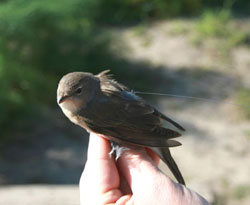Chubby birds get there faster

Garden warbler with sender.<br>Image: Wolfgang Goymann<br>
Small migratory birds, like the garden warbler, must make stopovers on their journeys to their breeding grounds. When they have crossed extensive ecological barriers, such as deserts or oceans, they must land to replenish their fat reserves. A researcher from the Max Planck Institute for Ornithology in Seewiesen and a team of Italian colleagues measured the duration of the stopovers made by garden warblers on an island off the Italian coast. There they observed that fat birds usually move on the night of their arrival, while thin birds interrupt their journey for an average of almost two days (Biology Letters, February 17, 2010).
While pockets of flab accumulated over the winter months may be a source of frustration for some, it can be a cause of joy for others: “Fat garden warblers can make shorter stops to replenish their fat reserves on the taxing annual journey to their breeding grounds,” reports Wolfgang Goymann of the Max Planck Institute for Ornithology in Seewiesen. The research results have shown that the duration of a bird’s stopover is not only influenced by environmental factors, such as wind and weather conditions, or a genetically-programmed internal urge: subcutaneous fat stores are the main factor behind the varying durations of the stopovers made during avian migration.
The researchers fitted ten fat birds and ten thin birds that landed on the Italian island of Ventotene in the morning on route to the north with temporary adhesive radio transmitters. They then monitored, at regular intervals, whether the signal emitted by the transmitters could still be heard on the island. Nine out of the ten fat birds flew on the same night; the thin birds, however, remained on the island for an average duration of 40 hours before resuming their journey. “We assume that the majority of the birds arrived on the island the morning we caught them,” says Wolfgang Goymann. “However, even if this were not the case, our data clearly revealed that fat garden warblers only waited until nightfall on the same day to move on. As opposed to this, the thin birds had to wait until they had accumulated sufficient fat reserves for the next leg of their journey.” The data demonstrates the importance of ecologically-intact resting grounds: The birds can only replenish their energy reserves quickly and move on to their breeding grounds swiftly and unfailingly if they can rest in areas with sufficient supplies of insects, nectar and pollen. Those that arrive early at the breeding ground can secure the best nesting sites.
Original work:
Wolfgang Goymann, Fernando Spina, Andrea Ferri and Leonida Fusani
Body fat influences departure from stopover sites in migratory birds: evidence from whole-island telemetry.
Biology Letters, DOI: 10.1098/rsbl.2009.1028
Contact:
Dr. Wolfgang Goymann
Max Planck Institute for Ornithology, Seewiesen
E-mail: goymann@orn.mpg.de
Media Contact
More Information:
http://www.mpg.de/english/All latest news from the category: Life Sciences and Chemistry
Articles and reports from the Life Sciences and chemistry area deal with applied and basic research into modern biology, chemistry and human medicine.
Valuable information can be found on a range of life sciences fields including bacteriology, biochemistry, bionics, bioinformatics, biophysics, biotechnology, genetics, geobotany, human biology, marine biology, microbiology, molecular biology, cellular biology, zoology, bioinorganic chemistry, microchemistry and environmental chemistry.
Newest articles

Pinpointing hydrogen isotopes in titanium hydride nanofilms
Although it is the smallest and lightest atom, hydrogen can have a big impact by infiltrating other materials and affecting their properties, such as superconductivity and metal-insulator-transitions. Now, researchers from…

A new way of entangling light and sound
For a wide variety of emerging quantum technologies, such as secure quantum communications and quantum computing, quantum entanglement is a prerequisite. Scientists at the Max-Planck-Institute for the Science of Light…

Telescope for NASA’s Roman Mission complete, delivered to Goddard
NASA’s Nancy Grace Roman Space Telescope is one giant step closer to unlocking the mysteries of the universe. The mission has now received its final major delivery: the Optical Telescope…



